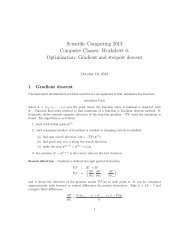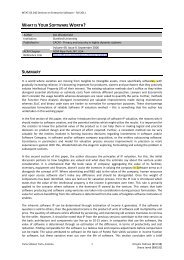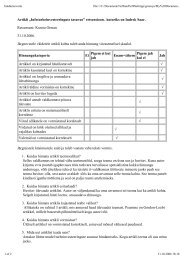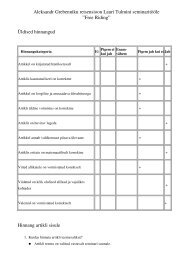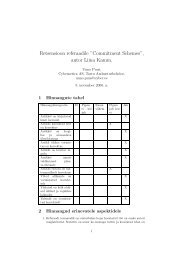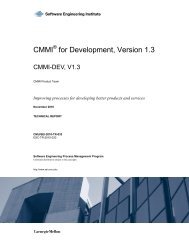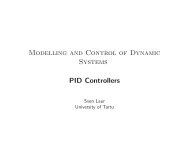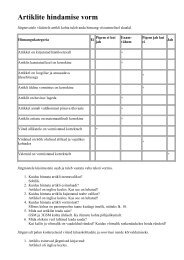On Non-Functional Requirements
On Non-Functional Requirements
On Non-Functional Requirements
You also want an ePaper? Increase the reach of your titles
YUMPU automatically turns print PDFs into web optimized ePapers that Google loves.
<strong>On</strong> <strong>Non</strong>-<strong>Functional</strong> <strong>Requirements</strong><br />
Martin Glinz<br />
Department of Informatics, University of Zurich, Switzerland<br />
glinz@ifi.uzh.ch<br />
Abstract<br />
Although the term ‘non-functional requirement’ has<br />
been in use for more than 20 years, there is still no<br />
consensus in the requirements engineering community<br />
what non-functional requirements are and how we<br />
should elicit, document, and validate them. <strong>On</strong> the<br />
other hand, there is a unanimous consensus that nonfunctional<br />
requirements are important and can be<br />
critical for the success of a project.<br />
This paper surveys the existing definitions of the<br />
term, highlights and discusses the problems with the<br />
current definitions, and contributes concepts for overcoming<br />
these problems.<br />
1. Introduction<br />
If you want to trigger a hot debate among a group of<br />
requirements engineering people, just let them talk<br />
about non-functional requirements. Although this term<br />
has been in use for more than two decades, there is still<br />
no consensus about the nature of non-functional requirements<br />
and how to document them in requirements<br />
specifications.<br />
This paper is an attempt to work out and discuss the<br />
problems that we have with the notion of non-functional<br />
requirements and to contribute concepts for<br />
overcoming these problems. The focus is on system (or<br />
product) requirements; the role of non-functional requirements<br />
in the software process is not discussed<br />
[16].<br />
The paper is organized as follows. Section 2 surveys<br />
typical definitions for the terms ‘functional requirement’<br />
and ‘non-functional requirement’. The<br />
problems with these definitions are discussed in Section<br />
3. Section 4 presents concepts about how these<br />
problems can be overcome or at least alleviated. The<br />
paper ends with a discussion of these concepts.<br />
2. Defining the term<br />
In every current requirements classification (for example<br />
[7], [11], [12]), we find a distinction between<br />
1090-705X/07 $25.00 © 2007 IEEE<br />
DOI 10.1109/RE.2007.45<br />
15th IEEE International <strong>Requirements</strong> Engineering Conference<br />
21<br />
requirements concerning the functionality of a system<br />
and other requirements.<br />
There is a rather broad consensus about how to define<br />
the term ‘functional requirements’. The existing<br />
definitions follow two threads that coincide to a large<br />
extent. In the first thread, the emphasis is on functions:<br />
a functional requirement specifies “a function that a<br />
system (...) must be able to perform” [6], “what the<br />
product must do” [18], “what the system should do”<br />
[20]. The second thread emphasizes behavior: functional<br />
requirements “describe the behavioral aspects of<br />
a system” [1]; behavioral requirements are “those requirements<br />
that specify the inputs (stimuli) to the system,<br />
the outputs (responses) from the system, and behavioral<br />
relationships between them; also called functional<br />
or operational requirements.” [3].<br />
Wiegers as well as Jacobson, Rumbaugh and Booch<br />
try a synthesis: “A statement of a piece of required<br />
functionality or a behavior that a system will exhibit<br />
under specific conditions.” [21]; “A requirement that<br />
specifies an action that a system must be able to perform,<br />
without considering physical constraints; a requirement<br />
that specifies input/output behavior of a<br />
system.” [10].<br />
There is only one semantic difference that may arise<br />
between the different definitions: timing requirements<br />
may be viewed as behavioral, while they are not functional.<br />
However, most publications in RE consider<br />
timing requirements to be performance requirements<br />
which in turn are classified as non-functional requirements.<br />
<strong>On</strong> the other hand, there is no such consensus for<br />
non-functional requirements. Table 1 gives an overview<br />
of selected definitions from the literature or the<br />
web, which – in my opinion – are representative of the<br />
definitions that exist.<br />
3. Where is the problem?<br />
The problems that we currently have with the notion<br />
of non-functional requirements can be divided into<br />
definition problems, classification problems and representation<br />
problems.<br />
Authorized licensed use limited to: University of Tartu IEL Trial. Downloaded on March 30,2010 at 04:00:21 EDT from IEEE Xplore. Restrictions apply.
Table 1. Definitions of the term non-functional requirement(s) (listed in alphabetical order of sources)<br />
Source Definition<br />
Antón [1] Describe the nonbehavioral aspects of a system, capturing the properties and constraints under<br />
which a system must operate.<br />
Davis [3] The required overall attributes of the system, including portability, reliability, efficiency, human<br />
engineering, testability, understandability, and modifiability.<br />
IEEE 610.12 [6] Term is not defined. The standard distinguishes design requirements, implementation requirements,<br />
interface requirements, performance requirements, and physical requirements.<br />
IEEE 830-1998 [7] Term is not defined. The standard defines the categories functionality, external interfaces,<br />
performance, attributes (portability, security, etc.), and design constraints. Project requirements<br />
(such as schedule, cost, or development requirements) are explicitly excluded.<br />
Jacobson, Booch and<br />
Rumbaugh [10]<br />
Kotonya and Sommerville<br />
[11]<br />
Mylopoulos, Chung and<br />
Nixon [16]<br />
A requirement that specifies system properties, such as environmental and implementation<br />
constraints, performance, platform dependencies, maintainability, extensibility, and reliability. A<br />
requirement that specifies physical constraints on a functional requirement.<br />
<strong>Requirements</strong> which are not specifically concerned with the functionality of a system. They place<br />
restrictions on the product being developed and the development process, and they specify external<br />
constraints that the product must meet.<br />
“... global requirements on its development or operational cost, performance, reliability,<br />
maintainability, portability, robustness, and the like. (...) There is not a formal definition or a<br />
complete list of nonfunctional requirements.”<br />
Ncube [17] The behavioral properties that the specified functions must have, such as performance, usability.<br />
Robertson and Robertson<br />
[18]<br />
A property, or quality, that the product must have, such as an appearance, or a speed or accuracy<br />
property.<br />
SCREEN Glossary [19] A requirement on a service that does not have a bearing on its functionality, but describes attributes,<br />
constraints, performance considerations, design, quality of service, environmental considerations,<br />
failure and recovery.<br />
Wiegers [21] A description of a property or characteristic that a software system must exhibit or a constraint that<br />
it must respect, other than an observable system behavior.<br />
Wikipedia: <strong>Non</strong>-<strong>Functional</strong><br />
<strong>Requirements</strong> [22]<br />
Wikipedia: <strong>Requirements</strong><br />
Analysis [23]<br />
3.1. Definition problems<br />
<strong>Requirements</strong> which specify criteria that can be used to judge the operation of a system, rather than<br />
specific behaviors.<br />
<strong>Requirements</strong> which impose constraints on the design or implementation (such as performance<br />
requirements, quality standards, or design constraints).<br />
When analyzing the definitions in Table 1, we find<br />
not only terminological, but also major conceptual<br />
discrepancies. Basically, all definitions build on the<br />
following terms: property or characteristic, attribute,<br />
quality, constraint, and performance. However, there is<br />
no consensus about the concepts that these terms denote.<br />
There are also cases where the meaning is not<br />
clear, because terms are used without a definition or a<br />
clarifying example.<br />
Property and characteristic seem to be used in their<br />
general meaning, i.e. they denote something that the<br />
system must have, which typically includes specific<br />
qualities such as usability or reliability, but excludes<br />
any functional quality. There is no consensus whether<br />
constraints also are properties: Jacobson, Booch and<br />
Rumbaugh [10] include them, others, e.g. Wiegers [21]<br />
and Antón [1] exclude them.<br />
Attribute is a term that is used both with a broad and<br />
a narrow meaning. In IEEE 830-1998 [7], attributes are<br />
a collection of specific qualities, excluding perform-<br />
22<br />
ance and constraints. <strong>On</strong> the other hand, in the definition<br />
by Davis [3], every non-functional requirement is<br />
an attribute of the system.<br />
Every requirement (including all functional ones)<br />
can be regarded as a quality, because, according to ISO<br />
9000:2000 [8], quality is the “degree to which a set of<br />
inherent characteristics fulfils requirements”. Similarly,<br />
every requirement can be regarded as a constraint,<br />
because it constrains the space of potential<br />
solutions to those that meet this requirement.<br />
Hence, in all definitions that mention the term quality,<br />
its meaning is restricted to a set of specific qualities<br />
other than functionality: usability, reliability, security,<br />
etc.<br />
Correspondingly, it is clear that constraint in the<br />
context of non-functional requirements must have a<br />
restricted meaning. However, there is no consensus<br />
among the existing definitions what precisely this restriction<br />
should be. For example, IEEE 830-1998 [7] or<br />
Jacobson, Booch and Rumbaugh [10] restrict the<br />
meaning of constraint to design constraints and physi-<br />
Authorized licensed use limited to: University of Tartu IEL Trial. Downloaded on March 30,2010 at 04:00:21 EDT from IEEE Xplore. Restrictions apply.
cal constraints. Others, for example the definition in<br />
the Wikipedia article on requirements analysis [23], do<br />
not treat constraints as a sub-category of non-functional<br />
requirements, but consider every non-functional<br />
requirement to be a constraint. Davis [3] does not<br />
mention constraints at all when discussing non-functional<br />
requirements. Robertson and Robertson [18]<br />
have a rather specific view of constraints: they consider<br />
operational, cultural, and legal constraints to be<br />
non-functional properties, whereas design constraints<br />
are regarded as a concept that is different from both<br />
functional and non-functional requirements.<br />
Performance is treated as a quality or attribute in<br />
many definitions. Others, e.g. IEEE 830-1998 [7] and<br />
Wikipedia [23] consider it as a separate category.<br />
Another discrepancy exists in the scope of nonfunctional<br />
requirements. Some definitions emphasize<br />
that non-functional requirements have, by definition, a<br />
global scope: “global requirements” (Mylopoulos,<br />
Chung and Nixon [16]), “overall attributes” (Davis<br />
[3]). Accordingly, proponents of this global view<br />
separate functional and non-functional requirements<br />
completely. For example, in the Volere template [18]<br />
they are documented in two separate top-level sections.<br />
<strong>On</strong> the other hand, Jacobson, Booch and Rumbaugh<br />
[10] emphasize that there are both local non-functional<br />
requirements (e.g. most performance requirements) and<br />
global requirements such as security or reliability.<br />
Most definitions refer to system requirements (also<br />
called product requirements) only and exclude project<br />
and process requirements either explicitly [7] or implicitly.<br />
However, in the definition by Kotonya and<br />
Sommerville [11], project requirements are considered<br />
to be non-functional requirements.<br />
Finally, the variety and divergence of concepts used<br />
in the definitions of non-functional requirements also<br />
lead to definitions containing elements that are obviously<br />
misconceived. For example, the SCREEN glossary<br />
[19] lists failure and recovery as non-functional<br />
properties, while behavior in the case of failure and<br />
recovery from failures are clearly functional issues.<br />
Ncube [17] even defines non-functional requirements<br />
as “the behavioral properties...”. Although this is more<br />
likely a severe typo than a misconception, the fact that<br />
this error went unnoticed in a PhD thesis illustrates the<br />
fuzziness of the current notions of non-functional requirements<br />
and the need for a clear and concise definition.<br />
The worst example is the definition in the Wikipedia<br />
article on non-functional requirements [22],<br />
which is so vague that it could mean almost anything.<br />
3.2. Classification problems<br />
When analyzing the definitions given in Table 1, we<br />
also find rather divergent concepts for sub-classifying<br />
23<br />
non-functional requirements. Davis [3] regards them as<br />
qualities and uses Boehm’s quality tree [2] as a subclassification<br />
for non-functional requirements. The<br />
IEEE standard 830-1998 on Software <strong>Requirements</strong><br />
Specifications [7] sub-classifies non-functional requirements<br />
into external interface requirements, performance<br />
requirements, attributes and design constraints,<br />
where the attributes are a set of qualities such<br />
as reliability, availability, security, etc. The IEEE<br />
Standard Glossary of Software Engineering Terminology<br />
[6] distinguishes functional requirements on the<br />
one hand and design requirements, implementation<br />
requirements, interface requirements, performance requirements,<br />
and physical requirements on the other.<br />
Sommerville [20] uses a sub-classification into product<br />
requirements, organizational requirements and external<br />
requirements.<br />
More classification problems arise due to mixing<br />
three concepts that should better be separated. These<br />
are the concepts of kind (should a given requirement be<br />
regarded as a function, a quality, a constraint, etc.),<br />
representation (see below), and satisfaction (hard vs.<br />
soft requirements). For an in-depth discussion of this<br />
problem, see [5].<br />
3.3. Representation problems<br />
As long as we regard any requirement that describes<br />
a function or behavior as a functional requirement, the<br />
notion of non-functional requirements is representation-dependent.<br />
Consider the following example: A<br />
particular security requirement could be expressed as<br />
“The system shall prevent any unauthorized access to<br />
the customer data”, which, according to all definitions<br />
given in Table 1 is a non-functional requirement. If we<br />
represent this requirement in a more concrete form, for<br />
example as “The probability for successful access to<br />
the customer data by an unauthorized person shall be<br />
smaller than 10 -5 ”, this is still a non-functional requirement.<br />
However, if we refine the original requirement<br />
to “The database shall grant access to the customer<br />
data only to those users that have been authorized<br />
by their user name and password”, we have a<br />
functional requirement, albeit it is still a security requirement.<br />
In a nutshell, the kind of a requirement<br />
depends on the way we represent it.<br />
A second representational problem is the lack of<br />
consensus where to document non-functional requirements.<br />
As discussed above, some authors recommend<br />
the documentation of functional and non-functional<br />
requirements in separate chapters of the software requirements<br />
specification. The Volere template [18] is a<br />
prominent example for this documentation style. In<br />
IEEE 830-1998 [7], seven of the eight proposed SRS<br />
templates also separate the functional requirements<br />
Authorized licensed use limited to: University of Tartu IEL Trial. Downloaded on March 30,2010 at 04:00:21 EDT from IEEE Xplore. Restrictions apply.
completely from the non-functional ones. <strong>On</strong> the other<br />
hand, when documenting requirements in a use-caseoriented<br />
style according to the Rational Unified Process<br />
[10], non-functional requirements are attached to<br />
use case as far as possible. <strong>On</strong>ly the remaining (global)<br />
non-functional requirements are documented separately<br />
as so-called supplementary requirements.<br />
However, there are also cases where a non-functional<br />
requirement affects neither a single functional<br />
requirement nor the system as a whole. Instead, it pertains<br />
to a specific set of functional requirements. For<br />
example, some subset of the set of all use cases may<br />
need secure communication, while the other use cases<br />
do not. Such a case cannot be documented adequately<br />
with classic requirements specification templates and<br />
must be handled by setting explicit traceability links.<br />
As we will see in the next chapter, aspect-orientation<br />
provides a solution for this problem.<br />
4. Elements of a solution<br />
4.1. A faceted classification<br />
In [5], I have proposed that the classification problems,<br />
and – in a radical sense – also the definition<br />
problems be overcome by introducing a faceted classification<br />
for requirements (Fig. 1) where the terms<br />
‘functional requirement’ and ‘non-functional requirement’<br />
no longer appear.<br />
Separating the concepts of kind, representation,<br />
satisfaction, and role has several advantages, for<br />
example: (i) It is the representation of a requirement<br />
(not its kind!) that determines the way in which we can<br />
verify that the system satisfies a requirement (Table 2).<br />
(ii) Decoupling the kind and satisfaction facets reflects<br />
the fact that functional requirements are not always<br />
hard and non-functional requirements not always soft.<br />
(iii) The role facet allows a clear distinction of (prescriptive)<br />
system requirements and (normative or<br />
assumptive) domain requirements.<br />
Figure 1. A faceted classification of requirements<br />
(from [5])<br />
However, when using this classification it turned<br />
out that the idea of getting rid of the terms ‘functional<br />
24<br />
requirement’ and ‘non-functional requirement’ is too<br />
radical. When practicing requirements engineering,<br />
there is a need to distinguish functional concerns from<br />
other, “non-functional” concerns and there is also a<br />
need for a sub-classification of the “non-functional”<br />
concerns in a clear and comprehensible way. In the<br />
next section, such a definition is presented.<br />
Table 2. Representation determines verification [5]<br />
Representation Type of verification<br />
Operational Review, test or formal verification<br />
Quantitative Measurement (at least on an ordinal scale)<br />
Qualitative No direct verification. May be done by<br />
subjective stakeholder judgment of deployed<br />
system, by prototypes or indirectly<br />
by goal refinement or derived metrics<br />
Declarative Review<br />
4.2. A definition based on concerns<br />
We define a taxonomy of terms that is based on the<br />
concept of concerns, which makes it independent of<br />
the chosen representation. We assume a requirements<br />
engineering context, where system is the entity whose<br />
requirements have to be specified.<br />
Furthermore, the taxonomy concentrates on system<br />
requirements. As project and process requirements are<br />
conceptually different from system requirements, they<br />
should be distinguished at the root level and not in a<br />
sub-category such as non-functional requirements.<br />
DEFINITION. A concern is a matter of interest in a system.<br />
A concern is a functional or behavioral concern if<br />
its matter of interest is primarily the expected behavior<br />
of a system or system component in terms of its reaction<br />
to given input stimuli and the functions and data<br />
required for processing the stimuli and producing the<br />
reaction. A concern is a performance concern if its<br />
matter of interest is timing, speed, volume or throughput.<br />
A concern is a quality concern if its matter of interest<br />
is a quality of the kind enumerated in ISO/IEC<br />
9126 [9].<br />
DEFINITION. The set of all requirements of a system is<br />
partitioned into functional requirements, performance<br />
requirements, specific quality requirements, and constraints.<br />
A functional requirement is a requirement that pertains<br />
to a functional concern.<br />
A performance requirement is a requirement that<br />
pertains to a performance concern.<br />
A specific quality requirement is a requirement that<br />
pertains to a quality concern other than the quality of<br />
meeting the functional requirements.<br />
A constraint is a requirement that constrains the<br />
solution space beyond what is necessary for meeting<br />
Authorized licensed use limited to: University of Tartu IEL Trial. Downloaded on March 30,2010 at 04:00:21 EDT from IEEE Xplore. Restrictions apply.
the given functional, performance, and specific quality<br />
requirements.<br />
An attribute is a performance requirement or a specific<br />
quality requirement.<br />
The taxonomy defined above is visualized in Figure<br />
2. In my opinion, this structure is sufficient and useful<br />
both for theoretical and practical work. For persons<br />
who do not want to dispose of the term ‘non-functional<br />
requirement’, we can define this term additionally as<br />
follows.<br />
DEFINITION. A non-functional requirement is an attribute<br />
of or a constraint on a system.<br />
Project<br />
requirement<br />
<strong>Functional</strong><br />
requirement<br />
Performance<br />
requirement<br />
<strong>Functional</strong>ity<br />
and behavior:<br />
Functions<br />
Data<br />
Stimuli<br />
Reactions<br />
Behavior<br />
Time and<br />
space bounds:<br />
Timing<br />
Speed<br />
Volume<br />
Throughput<br />
Requirement<br />
System<br />
requirement<br />
Attribute Constraint<br />
Specific quality<br />
requirement<br />
“-ilities”:<br />
Reliability<br />
Usability<br />
Security<br />
Availability<br />
Portability<br />
Maintainability<br />
Process<br />
requirement<br />
... ...<br />
Physical<br />
Legal<br />
Cultural<br />
Environmental<br />
Design&Implementation<br />
Interface<br />
Figure 2. A concern-based taxonomy of requirements<br />
Performance is a category of its own in our taxonomy<br />
(as well as in the IEEE standards [6] [7]) because performance<br />
requirements are typically treated separately<br />
in practice. This is probably due to the fact that measuring<br />
performance is not difficult a priori, while measuring<br />
other attributes is: there is a broad consensus to<br />
measure performance in terms of time, volume, and<br />
volume per unit of time. For any other attribute, there<br />
are no such generally agreed measures, which means<br />
that the task of eliciting specific qualities always implies<br />
finding an agreement among the stakeholders<br />
how to measure these qualities.<br />
Interfaces, which are a separate category in the<br />
IEEE standards [6] [7], no longer appear in the terminology<br />
defined above. An interface requirement is<br />
classified according to the concern it pertains to as<br />
functional, performance, specific quality, or constraint.<br />
Due to the systematic construction of our taxonomy,<br />
the task of classifying a given requirement becomes<br />
easier and less ambiguous. The often heard rule ‘What<br />
25<br />
the system does functional requirement; How the<br />
system behaves non-functional requirement’ [4] is<br />
too coarse and leads to mis-classifications when attributes<br />
and constraints are represented functionally or<br />
when they are very important 1 .<br />
Table 3 gives the classification rules for the taxonomy<br />
laid out in Figure 2.<br />
Table 3. Classification rules<br />
No 1 Question<br />
Was this requirement stated because we<br />
need to specify...<br />
Result<br />
1 ... some of the system’s behavior, data,<br />
input, or reaction to input stimuli – regardless<br />
of the way how this is done?<br />
<strong>Functional</strong><br />
2 ... restrictions about timing, processing<br />
or reaction speed, data volume, or<br />
throughput?<br />
Performance<br />
3 ... a specific quality that the system or a<br />
component shall have?<br />
4 ... any other restriction about what the<br />
system shall do, how it shall do it, or any<br />
prescribed solution or solution element?<br />
1<br />
Questions must be applied in this order<br />
4.3. Aspect-oriented representation<br />
Specific<br />
quality<br />
Constraint<br />
As soon as we structure the functional requirements<br />
specification systematically (by using a text template<br />
or by modeling requirements), the question about<br />
structuring the non-functional requirements comes up.<br />
Structuring attributes and constraints into sub-kinds<br />
according to a documentation template is helpful here,<br />
but clearly this is not enough; in particular when we<br />
have attributes and constraints that are neither completely<br />
local nor fully global, but pertain to some specific<br />
parts of the system.<br />
An aspect-oriented representation of requirements,<br />
in particular of attributes and constraints, helps overcome<br />
this problem. A multi-dimensional separation of<br />
concerns [15] allows every concern to be modeled<br />
separately. Thus, all concerns are treated equally,<br />
which looks clean and elegant from an academic viewpoint.<br />
However, in practice, there is almost always a<br />
dominant concern, which is typically a functional one.<br />
This concern is crosscut by other concerns, both functional<br />
and non-functional ones.<br />
In my research group, we have developed an aspectoriented-extension<br />
for a hierarchical modeling lan-<br />
1 For example, in particle physics, the detectors of contemporary<br />
accelerators produce enormous amounts of data in real time. When<br />
asked a ‘what shall the system do’ question about the data processing<br />
software for such a detector, one of the first answers a physicist typically<br />
would give would be that the system must be able to cope with<br />
the data volume. However, this is a performance requirement.<br />
Authorized licensed use limited to: University of Tartu IEL Trial. Downloaded on March 30,2010 at 04:00:21 EDT from IEEE Xplore. Restrictions apply.
guage [13], [14] where we identify a dominant functional<br />
concern and decompose the system model hierarchically<br />
according to the structure of this concern.<br />
All other concerns are modeled as aspects of this primary<br />
model. Aspect composition is supported by formal<br />
model weaving semantics.<br />
Thus we can document attributes and constraints as<br />
separate entities, but, at the same time, attach them<br />
systematically to those elements in the primary model<br />
hierarchy where they apply. Global attributes and constraints<br />
are attached to the root of the decomposition<br />
hierarchy, while an attribute or constraint that restricts<br />
only some parts of the model is attached exactly to<br />
these parts by modeling join relationship from the aspect<br />
to the affected parts of the primary model.<br />
5. Discussion<br />
The analysis of the definitions given in Table 1 reveals<br />
the deficiencies of the current terminology. The<br />
new definitions proposed in this paper<br />
• are more systematically constructed than any existing<br />
definitions that I am aware of,<br />
• are representation-independent; i.e. the kind of a<br />
requirement is always the same, regardless of its representation,<br />
• make it easier to classify a given requirement: with<br />
the classification criteria given in Table 3, the classification<br />
is much less ambiguous than with traditional<br />
definitions,<br />
• better support the evolution of a requirements specification,<br />
because the classification of a requirement<br />
remains invariant under refinement and change as<br />
long as the concern to which the requirements pertains<br />
remains the same.<br />
With an aspect-oriented documentation of attributes<br />
and constraints, the documentation and traceability<br />
problems of non-functional requirements are alleviated.<br />
As this is mainly theoretical work, the validation of<br />
the theoretical soundness and usefulness of these ideas<br />
will be the extent to which other researchers find these<br />
ideas useful and adopt or build upon them.<br />
The systematic exploration of the practical usefulness<br />
is a topic for further investigation.<br />
References<br />
[1] A. Antón (1997). Goal Identification and Refinement in<br />
the Specification of Information Systems. PhD Thesis,<br />
Georgia Institute of Technology.<br />
[2] B. Boehm et al. (1976). Quantitative Evaluation of<br />
Software Quality. Proc. 2nd IEEE International Conference<br />
on Software Engineering. 592-605.<br />
[3] A. Davis (1993). Software <strong>Requirements</strong>: Objects, Functions<br />
and States. Prentice Hall.<br />
26<br />
[4] X. Franch (1998). Systematic Formulation of <strong>Non</strong>-<br />
<strong>Functional</strong> Characteristics of Software. Proc. 3rd Int'l<br />
Conf. <strong>Requirements</strong> Engineering (ICRE’98). 174-181.<br />
[5] M. Glinz (2005). Rethinking the Notion of <strong>Non</strong>-<strong>Functional</strong><br />
<strong>Requirements</strong>. Proc. Third World Congress for<br />
Software Quality (3WCSQ 2005), Munich, Germany,<br />
Vol. II. 55-64.<br />
[6] IEEE (1990). Standard Glossary of Software Engineering<br />
Terminology. IEEE Standard 610.12-1990.<br />
[7] IEEE (1998). IEEE Recommended Practice for Software<br />
<strong>Requirements</strong> Specifications. IEEE Std. 830-1998.<br />
[8] ISO 9000 (2000). Quality Management Systems – Fundamentals<br />
and Vocabulary. International Organization<br />
for Standardization.<br />
[9] ISO/IEC 9126-1 (2001). Software Engineering – Product<br />
Quality – Part 1: Quality Model. International Organization<br />
for Standardization.<br />
[10] I. Jacobson, G. Booch, and J. Rumbaugh (1999). The<br />
Unified Software Development Process. Reading,<br />
Mass.: Addison Wesley.<br />
[11] G. Kotonya, I. Sommerville (1998). <strong>Requirements</strong> Engineering:<br />
Processes and Techniques. John Wiley & Sons.<br />
[12] A. van Lamsweerde (2001). Goal-Oriented <strong>Requirements</strong><br />
Engineering: A Guided Tour. Proc. 5th International<br />
Symposium on <strong>Requirements</strong> Engineering<br />
(RE’01), Toronto. 249-261.<br />
[13] S. Meier, T. Reinhard, C. Seybold, and M. Glinz<br />
(2006). Aspect-Oriented Modeling with Integrated Object<br />
Models. Proc. Modellierung 2006, Innsbruck,<br />
Austria. 129-144.<br />
[14] S. Meier, T. Reinhard, R. Stoiber, M. Glinz (2007).<br />
Modeling and Evolving Crosscutting Concerns in<br />
ADORA. Proc. Early Aspects at ICSE: Workshop in Aspect-Oriented<br />
<strong>Requirements</strong> Engineering and Architecture<br />
Design.<br />
[15] A. Moreira, A. Rashid, and J. Araújo (2005). Multi-<br />
Dimensional Separation of Concerns in <strong>Requirements</strong><br />
Engineering. Proc. 13th IEEE International <strong>Requirements</strong><br />
Engineering Conference (RE’05). 285-296.<br />
[16] J. Mylopoulos, L. Chung, B. Nixon (1992). Representing<br />
and Using <strong>Non</strong>functional <strong>Requirements</strong>: A Process-<br />
Oriented Approach. IEEE Transactions on Software<br />
Engineering 18, 6 (June 1992). 483-497.<br />
[17] C. Ncube (2000). A <strong>Requirements</strong> Engineering Method<br />
for COTS-Based Systems Development. PhD Thesis,<br />
City University London.<br />
[18] S. Robertson and J. Robertson (1999). Mastering the<br />
<strong>Requirements</strong> Process. ACM Press.<br />
[19] SCREEN (1999). Glossary of EU SCREEN Project.<br />
http://cordis.europa.eu/infowin/acts/rus/projects/screen/<br />
glossary/glossary.htm (visited 2007-07-05)<br />
[20] I. Sommerville (2004). Software Engineering, Seventh<br />
Edition. Pearson Education.<br />
[21] K. Wiegers (2003). Software <strong>Requirements</strong>, 2nd edition.<br />
Microsoft Press.<br />
[22] Wikipedia: <strong>Non</strong>-<strong>Functional</strong> <strong>Requirements</strong><br />
http://en.wikipedia.org/wiki/<strong>Non</strong>-functional_requirements<br />
(visited 2007-07-05)<br />
[23] Wikipedia: <strong>Requirements</strong> Analysis http://en.wikipedia.org<br />
/wiki/<strong>Requirements</strong>_analysis (visited 2007-07-05)<br />
Authorized licensed use limited to: University of Tartu IEL Trial. Downloaded on March 30,2010 at 04:00:21 EDT from IEEE Xplore. Restrictions apply.



